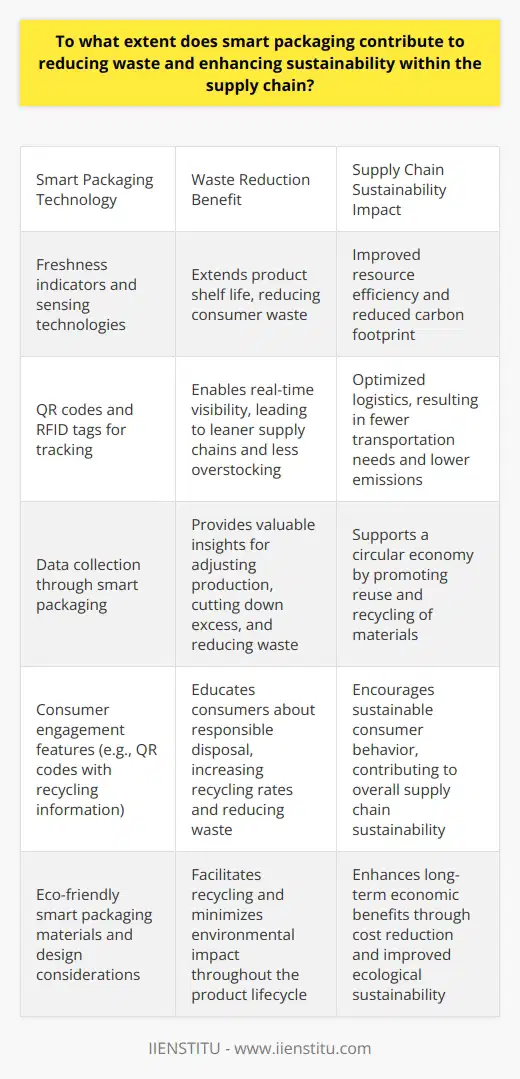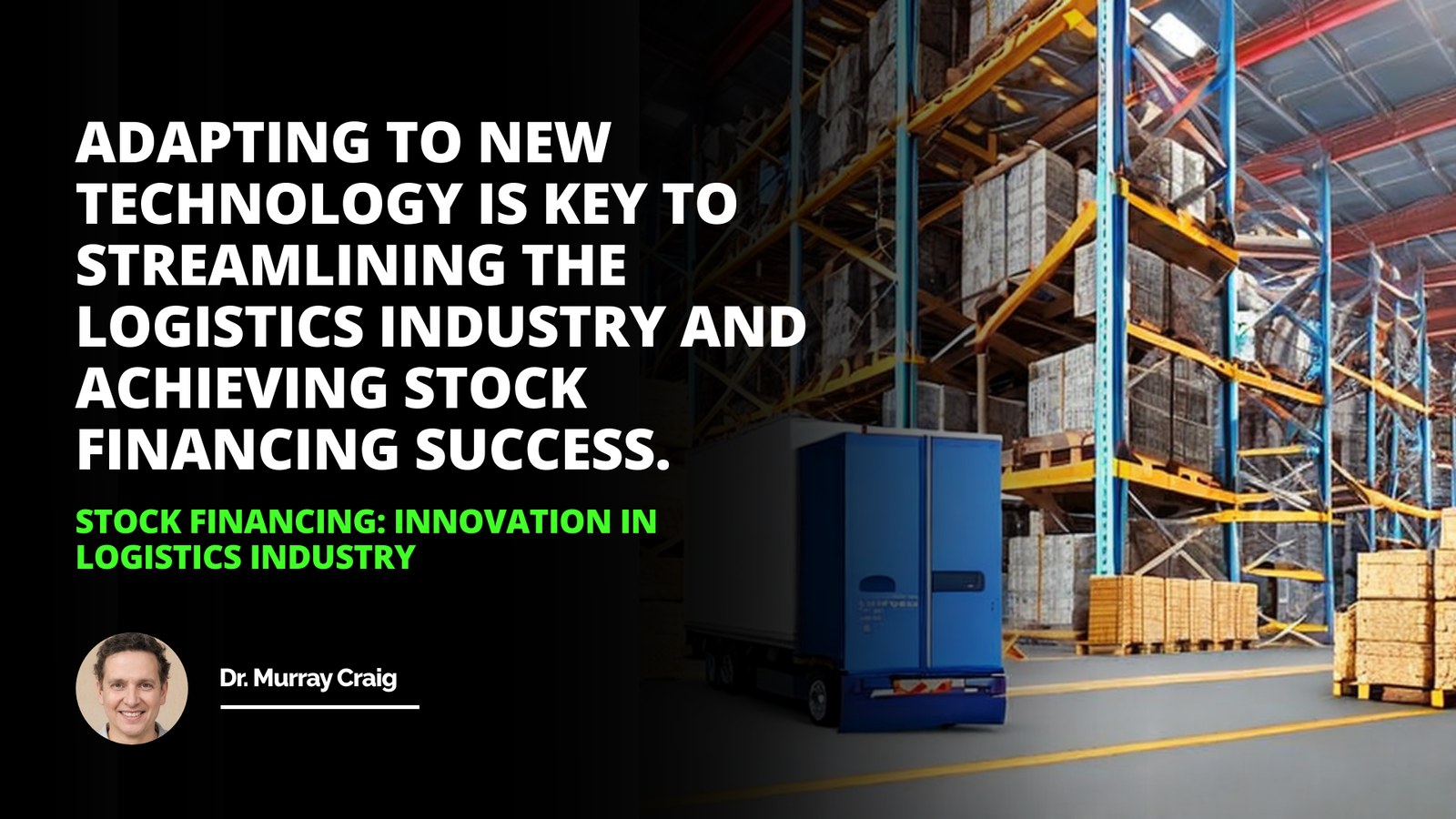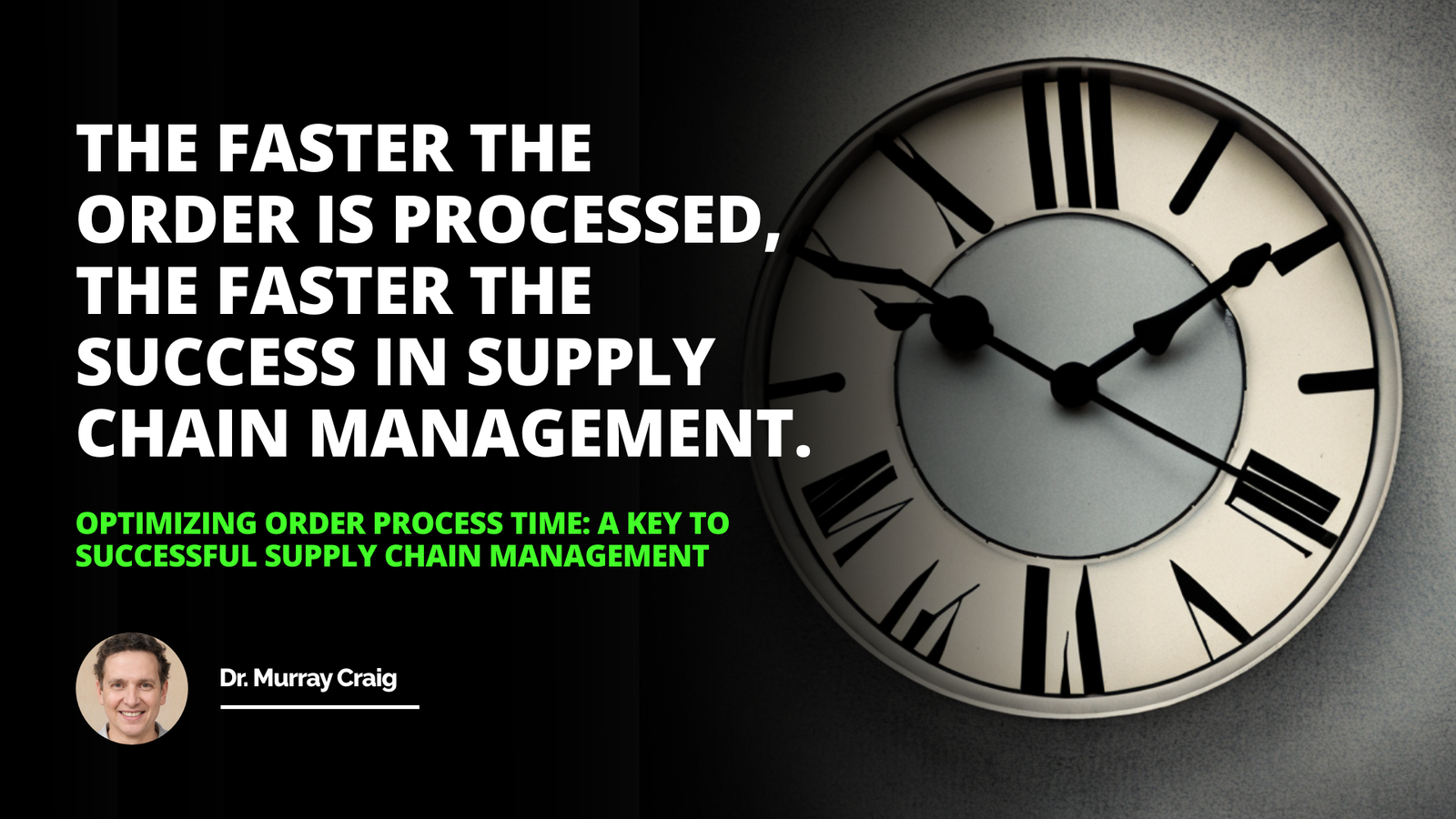
As the logistics and packaging industries continually evolve with the integration of cutting-edge technologies, one innovation stands out for its profound capacity to reshape supply chain dynamics: smart packaging. Integrating intelligence and functionality, smart packaging goes beyond the traditional roles of containment and protection, offering interactive experiences and real-time data to both businesses and consumers. It's an exciting era for those invested in shipping logistics courses and certificate courses online, as these educational platforms are increasingly addressing the merger of technology and supply chain management.
In this article, we will explore the concept of smart packaging, its multi-faceted impact on supply chain efficiency, and how emerging technologies continue to elevate its capabilities. Our analysis will navigate through practical examples, regulatory challenges, and the exciting potential future trends within this innovative field.
Introduction to Smart Packaging
Definition and Explanation of Smart Packaging
Smart packaging refers to the integration of advanced technologies into packaging design, transforming the traditional packaging into a dynamic solution that communicates with consumers and supply chain managers.
By embedding sensors, indicators, and communication devices, smart packaging offers a new dimension of interaction, monitoring, and data analysis. This transformative approach opens numerous opportunities for quality control, authenticity verification, and consumer engagement.
Brief History and Development of Smart Packaging
The evolution of smart packaging has been catalyzed by the advent of microelectronics and IoT. Initially modest in their applications, early forms of smart packaging primarily focused on tracking and freshness indicators. However, as technology has advanced, so has the scope and sophistication of smart packaging solutions, encompassing everything from enhanced user experiences to intricate logistics optimization systems.
The Importance of Smart Packaging
The Impact on the Business Sector
Enhancement in Product Safety
One of the primary benefits of smart packaging in business is the marked enhancement in product safety. Incorporated sensors can track environmental conditions such as temperature and humidity, which are essential for perishable goods. This real-time monitoring allows for immediate intervention when conditions deviate from optimal ranges, significantly mitigating the risk of spoilage and loss.
Improvement in Brand Value and Customer Loyalty
Smart packaging fortifies brand value by bolstering consumer trust through transparency and authenticity. Features such as tamper-evident seals and authenticity checkers combat counterfeiting. Brands can also use smart packaging to provide consumers with engaging content and personalized experiences, fostering a deeper connection and enhancing customer loyalty.
Efficient Supply Chain Management
For supply chain management, smart packaging acts as a pivotal tool in reducing waste, optimizing inventory, and streamlining logistics operations. With the ability to track products in real time, companies are more agile in responding to market demands, lowering the incidence of overstock or stockouts, and improving overall supply chain efficiency.
The Impact on the Consumer Sector
Assurance of Product Quality
Consumers gain an assurance of product quality through smart packaging. The use of intelligent indicators, such as time-temperature indicators, allows consumers to ascertain the freshness and suitability of food products before making a purchase, heightening consumer confidence in the quality of their selections.
Ease in Product Usability
Smart packaging also introduces an element of convenience and added functionality into product usage. Features like resealable closures, portion control dispensing, and improved ergonomics are user-oriented enhancements driven by smart design moderated through consumer feedback.
Access to Detailed Product Information
Finally, smart packaging provides a platform for consumers to access in-depth product information seamlessly. With technologies such as QR codes, consumers can interact with packages using their smartphones to unlock a plethora of data—nutritional content, usage instructions, and even the product’s journey from source to shelf.
Types of Smart Packaging
Active Packaging
Role and Significance of Active Packaging
Active packaging plays a proactive role in extending product shelf life and maintaining quality. Incorporating substances that can interact with the contents or the packaging environment, active packaging systems might release preservatives or absorb excess moisture, for instance, combating deterioration factors actively within the packaging ecosystem.
Examples of Active Packaging
Examples of active packaging include oxygen scavengers used in meat and fish products to prolong freshness, ethylene absorbers that delay ripening in fruit packaging, or moisture regulators found in the packaging of electronics to prevent corrosion.
Intelligent Packaging
Role and Significance of Intelligent Packaging
Intelligent packaging goes a step further, embodying a communication function that provides information about the condition of the product or its environment. With the usage of sensors and indicators, intelligent packaging becomes a critical tool for real-time data acquisition and interpretation.
Examples of Intelligent Packaging
Intelligent packaging often materializes in the form of freshness indicators, which change color based on the chemical changes within the food product, or RFID tags, which enable tracking and traceability throughout the product’s journey in the supply chain.
Technological Advancements in Smart Packaging
Use of QR Codes and NFC Technology
QR codes and NFC (Near Field Communication) technology are two innovations widely adopted in smart packaging. QR codes, scanned by any smartphone, can direct consumers to product information, promotional content, and traceability data. NFC chips embedded in packaging permit touch-based interaction with smartphones, offering a higher level of security and user engagement.
Incorporation of Augmented Reality (AR)
Augmented Reality is elevating the consumer experience by blending the physical and digital worlds. Through smart packaging, AR provides interactive and immersive experiences, such as 3D product visualizations, which not only mesmerize consumers but also aid in complex product assemblies or usage.
Advent of Internet of Things (IoT) in Smart Packaging
The Internet of Things has revolutionized smart packaging by embedding connected devices that can communicate with the broader digital ecosystem. This connectivity facilitates a higher order of supply chain monitoring and insight, enabling predictive analytics for inventory management and dynamic pricing strategies.
Examples of How These Technologies are Applied in Smart Packaging
Examples of these technologies in action include interactive wine labels that offer a virtual vineyard tour when scanned, medicine packaging that reminds patients when to take their pills, and packages that adjust their internal conditions in response to external temperature fluctuations, thus actively protecting the product.
Future Trends in Smart Packaging
Sustainability in Smart Packaging
The push for sustainability is shaping the next wave of smart packaging designs. Bio-based materials, biodegradable circuits, and the reduction of electronic waste are areas of intensive development, aiming to fuse high-tech capabilities with environmental stewardship.
Personalization and Customization in Smart Packaging
Tailoring consumer experiences through personalization is another growing trend. Future smart packaging may incorporate algorithms that adapt content and promotions based on consumer preferences, gathered intelligently through interaction data.
Predictive Analysis and Machine Learning in Smart Packaging
Predictive analysis and machine learning in smart packaging can refine supply chain forecasts, enhance product rotation strategies, and yield more efficient recalls when necessary. By learning from past data, smart packaging systems will become more anticipatory and responsive, enabling businesses to stay ahead of market trends.
Challenges and Regulatory Concerns in Smart Packaging
Cost and Affordability Issues
Implementing smart packaging solutions often entails significant upfront costs, which can pose affordability challenges for small to mid-sized enterprises. The economic barriers associated with advanced packaging technologies must be mitigated to ensure broader adoption across the industry spectrum.
Data Privacy and Security Concerns
With an increased flow of sensitive data between packaging and consumers or businesses, data privacy and security emerge as critical concerns. Strategies to protect consumer information and company proprietary data are essential components of smart packaging implementations.
Regulatory Frameworks and Compliance Issues
Finally, as technology evolves faster than regulatory frameworks, compliance issues become more complex. Ensuring that smart packaging adheres to international standards and local legislation is vital for its successful integration into global supply chains.
Summary of Key Points Discussed
Smart packaging represents a significant shift in how products are packaged, presented, and tracked. Integrating with technologies such as AR, IoT, and machine learning, smart packaging offers enhanced consumer engagement, optimized supply chain processes, and a profound impact on product lifecycle management. The demand for sustainable, personalized, and intelligent packaging is likely to intensify as businesses and consumers increasingly seek efficiency, authenticity, and transparency.
The Potential Growth and Advancement of Smart Packaging
While the road ahead is paved with challenges related to implementation costs, data privacy, and compliance, the potential growth and advancement of smart packaging remain undeniably robust. As smart packaging becomes more advanced and accessible, it promises to be a cornerstone in the future of supply chain management, product differentiation, and consumer satisfaction.
Frequently Asked Questions
How does smart packaging increase visibility within the supply chain process?
Understanding Smart Packaging
Smart packaging transforms traditional packaging. It introduces features beyond containment and protection. This technology usually includes QR codes, RFID tags, and sensors. They enable interaction with the supply chain.
Visibility Enhancement by Smart Packaging
Quick Scanning and Tracking
Smart packaging integrates quickly with supply chains. Tags like RFID enable instant item recognition. Handheld scanners read these tags effortlessly. This process cuts down time needed to manage inventory.
Real-time Data Access
RFID and similar technologies offer immediate data retrieval. Scanners read tags in bulk, without unboxing. Thus, supply chains gain insights without delay. They know the location of items at all times.
Condition Monitoring
Smart packaging often includes sensors. They track temperature, humidity, and more. So, supply chains can monitor conditions in real-time. This is crucial for sensitive goods.
Anti-Theft Features
Theft within supply chains can be a risk. Tags in smart packaging alert users to unauthorized access. These alerts improve security and reduce loss.
Inventory Management
Smart packaging simplifies counting processes. Sensors ease the tallying of items in storage areas. This improves inventory accuracy and predicts demand.
Shelf Life Optimization
Sensors monitor product conditions and expiry dates. They communicate this data promptly. Supply chains use the data to reduce waste.
Enhanced Consumer Engagement
Smart packaging often aims at post-sale engagement. Consumers scan QR codes for product information. This interaction produces data for supply chains.
Authentication
Counterfeit items pose a massive challenge. Smart tags help authenticate products within the supply chain. They ensure that genuine products reach consumers.
Benefits of Enhanced Visibility
Efficiency Gains
Supply chains become more efficient with smart packaging. Better data means more informed decisions. Operations speed up, and costs reduce.
Risk Mitigation
Supply chains manage risks proactively with smart packaging. Real-time data help anticipate issues. They allow for prompt corrective actions.
Customer Satisfaction
End-to-end visibility ensures customers receive the right product in perfect condition. It enhances trust and loyalty.
Compliance Assurance
Regulated products require strict monitoring. Sensors ensure conditions meet compliance standards. They provide evidence if required.
Sustainability Tracking
Sustainable practices are essential today. Smart packaging tracks sustainability metrics. It assists in reporting and improving green practices.
Conclusion
Smart packaging revolutionizes supply chain management. Short, straightforward sentences express complex ideas about technology and logistics. Hopefully, this academic style makes the content clear and insightful. Smart packaging ensures products move through supply chains with efficiency, security, and intelligence. It adds a layer of sophistication that benefits all stakeholders, from suppliers to consumers.
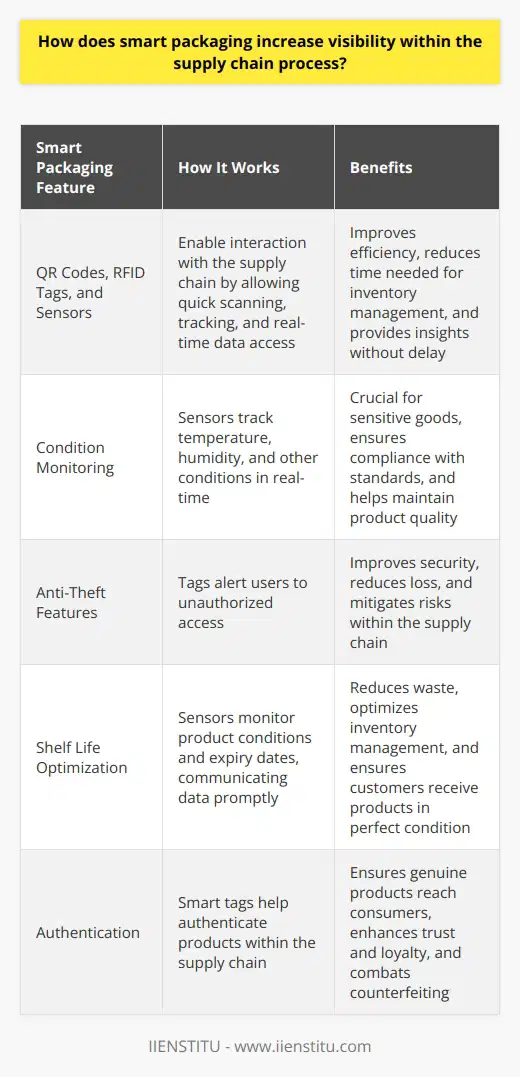
What are the measurable impacts of implementing smart packaging solutions on supply chain efficiency?
Introduction to Smart Packaging in Supply Chains
Smart packaging incorporates advanced technologies. These technologies intend to improve supply chain practices. Their inclusion offers various measurable benefits.
Cost Reduction
Smart packaging cuts operational costs. It reduces material waste. Efficient design needs fewer resources. Automated data collection lowers labor expenses. Theft and loss decrease due to improved tracking.
Improved Inventory Management
Smart packaging enables real-time inventory tracking. Sensors and RFID tags monitor stock levels automatically. This ensures optimal inventory levels. It also prevents overstocking and stockouts. Demand forecasting becomes more accurate.
Enhanced Product Integrity
Smart packages monitor the product condition. They track temperature and humidity. This is pivotal for perishable goods. Consumers thus receive items in the best condition. Product waste declines. Companies face fewer returns.
Reduced Environmental Impact
Eco-friendly smart packaging is on the rise. It uses biodegradable materials. The advanced tracking also optimizes logistics. Fewer transportation miles mean reduced carbon emissions. Firms can thus meet sustainability goals more easily.
Better Consumer Engagement
QR codes and NFC technologies link to digital content. They offer enhanced product information. Personalized marketing messages are possible. Consumer experience markedly improves. Brand loyalty experiences a resultant boost.
Streamlined Logistics
Logistics processes gain from smart packaging. Real-time location tracking facilitates route optimization. Deliveries get faster. Fuel consumption lowers. Logistics providers deliver more parcels with less effort.
Regulatory Compliance
Smart packaging simplifies compliance with regulations. It ensures proper handling and storage. Documentation is automatic and error-free. Compliance costs reduce. Legal risks lessen.
Data-Driven Insights
Advanced analytics come from smart packaging data. They reveal consumer behavior and preferences. Supply chains can then become more responsive. Firms can tailor products to market demands.
Conclusion
Implementing smart packaging has clear benefits. These affect supply chain efficiency profoundly. Costs drop. Inventory management becomes more efficient. Product integrity remains high. In sum, smart packaging is reshaping supply chains in measurable, positive ways.
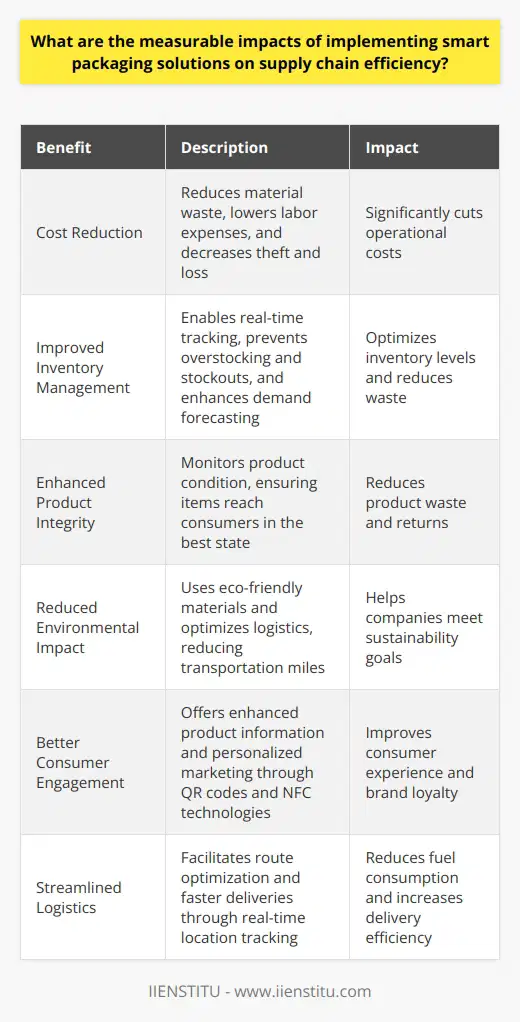
To what extent does smart packaging contribute to reducing waste and enhancing sustainability within the supply chain?
The Role of Smart Packaging in Waste Reduction
Smart Packaging Basics
Smart packaging employs advanced technologies. These enhance product experience. They also improve sustainability. Examples include freshness indicators. There are also QR codes and RFID tags. These features track products.
Waste Reduction Through Smart Packaging
Smart packaging contributes to significant waste reduction. It does so in various ways.
Enhanced Product Life
Smart packaging often extends product shelf life. It does this through indicators. These monitor product freshness. Sensing technologies also come into play. They regulate package environments. Consumers waste less as a result. They consume more of what they buy.
Efficient Logistics
Tracking features improve logistics. They do so by enabling real-time visibility. This visibility allows for better inventory management. Supply chains become leaner. Overstocking issues reduce. Likewise, unsold products decrease. This translates to less waste.
Data-Driven Decisions
Data collection is pivotal. Smart packaging provides valuable data. Manufacturers gain insights. They understand consumption patterns better. Production adjusts accordingly. Excess is cut down. Efficiency climbs. Hence, waste diminishes.
Consumer Engagement
Smart packaging also involves consumer engagement. QR codes are a good example. They offer more information. Consumers learn about recycling. They understand how to dispose of products responsibly. This educates them. Educated consumers tend to make greener choices. Recycling rates go up. Waste drops.
Challenges to Consider
Despite these advantages, challenges exist. Smart materials may complicate recycling. Thus, design considerations are crucial. The entire lifecycle warrants attention. Otherwise, sustainability benefits lessen.
Impact on Supply Chain Sustainability
Resource Efficiency
Smart packaging makes resource use more efficient. Materials are better utilized. Energy consumption in the supply chain drops. This equates to a smaller carbon footprint.
Reduction in Transportation Emissions
Efficient logistics mean fewer transportation needs. The reason is optimized routes. It also involves lesser frequency in replenishment. These lead to lower emissions. The environment benefits as a result.
Support for Circular Economy
A circular economy aims for sustainability. Smart packaging supports this aim. It promotes the reuse of materials. It also encourages recycling. We move away from the take-make-dispose model.
Long-Term Economic Benefits
Economic benefits are clear. Efficiency saves money. Waste reduction equals cost reduction. The supply chain thus becomes more sustainable. Both ecologically and economically.
Final Thoughts
Smart packaging evidently reduces waste. It enhances supply chain sustainability. Bold steps are necessary. The industry must adopt smart packaging. It must also tackle associated challenges. Sustainability goals are within reach. Smart packaging can indeed lead the way.
